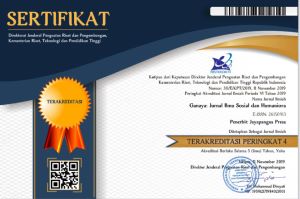Wayang Kulit Bali Sebagai Media Komunikasi
Keywords:
Balinese Wayang Kulit, Communication MediaAbstract
Communication of traditional wayang kulit performance art as one of the communication media that still has a place of honor and is favored by the majority of Balinese Hindus. The main function of the Balinese shadow puppet show is a dish that is enjoyed as a spectacle, but the shadow puppet show is sometimes coupled with certain ceremonies. Due to the existence of public trust in the sacred value of shadow puppets and can also be integrated with ceremonies that are held, complementary, or only accompanying. The ceremony is intended to glorify the ancestors, expressing gratitude and relating to a request is an important event that is considered sacred and needs to be completed or accompanied by performing arts at the time of its implementation. The Balinese shadow puppet show is presented in one form of story in the play so that the shadow puppet show contains a lot of value in it. The Balinese wayang kulit performance as a classic communication medium that presents various functions such as conveying information, teaching, and moral education does not only use classical or traditional values. Puppet shows also present universal values such as depictions of human life, good behavior that must be chosen by humans.
References
Dibia, I Wayan. “ Dari Wacak ke Kocak” Mudra 3, III, 1995 : 51-68.
Groenendael, Victoria M. Clara Van, 1987, Dalang Di Balik Wayang. Jakarta : PT Pustaka Utama Grafiti.
Hobart, Angela.1987. Dancing Shadow of Bali, Theatre and Myth. London and New York : KPI
Jaeni, 2012, Komunikasi Estetik Menggagas Kajian Seni dari Peristiwa Komunikasi Pertunjukan. Bogor : Institut Pertanian Bogor Press.
Kartodirdjo, Sartono, 1976, Sejarah Nasional Indonesia Jilid II. Jakarta : Departemen Pendidikan Dan Kebudayaan.
Kartodirdjo, Sartono, 1982, Pemikiran Dan Perkembangan Historiografi Indonesia Suatu Alternatif. Jakarta : Gramedia.
Kementrian komunikasi dan Informatika RI, 2001, Wayang Sebagai Media Komunikasi Tradisional Dalam Diseminasi Informasi, Jakarta: Kementiran Komunikasi Dan Informatika RI).
Mulyono, Sri, 1983, Simbolisme Dan Mistikisme Dalam Wayang Sebuah Tinjauan Filosofis. Jakarta : Gunung Agung.
Muyono, Sri, 1978, Wayang Asal Usul, Filsafat Dan Masa Depannya. Jakarta : Gunung Agung.
Poesponegoro dan Notosusanto, 1984. Sejarah Nasional Indonesia II. Jakarta : PN Balai Pustaka
Soedarsono, 1974, Beberapa Catatan Tentang Seni Pertunjukan Indonesia. Yogyakarta : Konservatori Tari Indonesia.
Solichin, 2010. Wayang Masterpiece Seni Budaya Dunia. Jakarta. Sinergi Persadatama Foundation.
Sutaba, dkk. 2007. Sejarah Gianyar Dari Jaman Prasejarah Sampai Masa Baru-Modern. Gianyar : Pemerintah Kabupaten Gianyar, Badan Penelitian Dan Pengembangan Daerah.
Wicaksana, I Dewa Ketut. 2007. Wayang Sapuh Leger Fungsi dan Maknanya dalam Masyarakat Bali. Denpasar : Pustaka Bali Post
Downloads
Published
How to Cite
Issue
Section
License
An author who publishes in the Ganaya : Jurnal Ilmu Sosial dan Humaniora agrees to the following terms:
- Author retains the copyright and grants the journal the right of first publication of the work simultaneously licensed under the Creative Commons Attribution-ShareAlike 4.0 License that allows others to share the work with an acknowledgement of the work's authorship and initial publication in this journal
- Author is able to enter into separate, additional contractual arrangements for the non-exclusive distribution of the journal's published version of the work (e.g., post it to an institutional repository or publish it in a book) with the acknowledgement of its initial publication in this journal.
- Author is permitted and encouraged to post his/her work online (e.g., in institutional repositories or on their website) prior to and during the submission process, as it can lead to productive exchanges, as well as earlier and greater citation of the published work (See The Effect of Open Access).
Read more about the Creative Commons Attribution-ShareAlike 4.0 Licence here: https://creativecommons.org/licenses/by-sa/4.0/.








